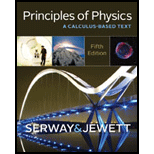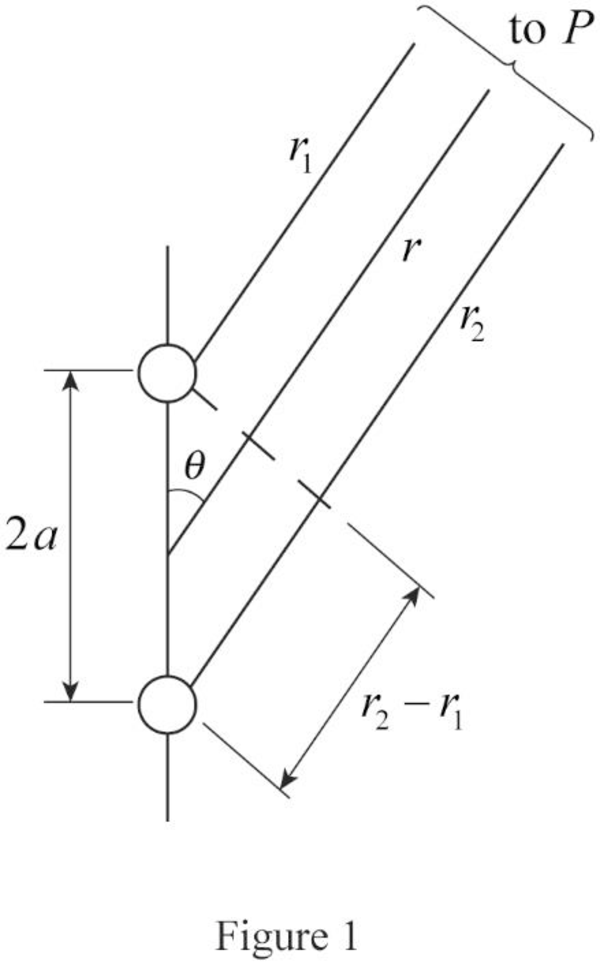
Concept explainers
(a)
The expression for the electric potential.
(a)
Answer to Problem 82P
The expression for the electric potential is
Explanation of Solution
The diagram for the system is given by figure 1.

Write the expression total potential.
Here,
Write the equation for potential difference at first point.
Here,
Write the equation for potential difference at second point.
Here,
For
Here.
The distance between the points are almost same,
Write the expression for dipole.
Conclusion:
Substitute,
Thus, the expression for the electric potential is
(b)
The radial and perpendicular component of electric field.
(b)
Answer to Problem 82P
The radial and perpendicular component of electric field is
Explanation of Solution
Write the expression for the radial component of electric field.
Here,
Write the equation for perpendicular component of electric field.
Here,
Conclusion:
Substitute,
Substitute,
Thus, the radial and perpendicular component of electric field is
(c)
The electric field at
(c)
Answer to Problem 82P
The electric field at
Explanation of Solution
Write the expression for the radial component of electric field.
Write the expression for the perpendicular component of electric field.
Conclusion:
For
Substitute,
For
Substitute,
The results are reasonable since the component of electric field is having finite value.
Thus, the electric field at
(d)
The electric field at
(d)
Answer to Problem 82P
The electric field at
Explanation of Solution
Write the expression for the radial component of electric field.
Write the expression for the perpendicular component of electric field.
Conclusion:
Substitute,
The electric field at the centre of dipole is not infinite.
The results are not reasonable since the component of electric field is having infinite value.
Thus, The electric field at
(e)
The potential in Cartesian coordinate.
(e)
Answer to Problem 82P
The potential in Cartesian coordinate is
Explanation of Solution
Write the expression for the potential.
Conclusion:
Substitute,
Thus, the potential in Cartesian coordinate is
(f)
The x and y component of electric field.
(f)
Answer to Problem 82P
The x and y component of electric field is
Explanation of Solution
Write the expression for the x component of electric field.
Here,
Write the equation for y component of electric field.
Here,
Conclusion:
Substitute,
Substitute,
Thus, the x and y component of electric field is
Want to see more full solutions like this?
Chapter 20 Solutions
Principles of Physics
- Given two particles with 2.00-C charges as shown in Figure P20.9 and a particle with charge q = 1.28 1018 C at the origin, (a) what is the net force exerted by the two 2.00-C charges on the test charge q? (b) What is the electric field at the origin due to the two 2.00-C particles? (c) What is the electric potential at the origin due to the two 2.00-C particles? Figure P20.9arrow_forwardTwo charged particles of equal magnitude are located along the y axis equal distances above and below the x axis as shown in Figure P24.14. (a) Plot a graph of the electric potential at points along the x axis over the interval 3a x 3a. You should plot the potential in units of keQ/a. (b) Let the charge of the particle located at y = a be negative. Plot the potential along the y axis over the interval 4a y 4a. Figure P24.14arrow_forwardFIGURE P26.14 Problems 14, 15, and 16. Four charged particles are at rest at the corners of a square (Fig. P26.14). The net charges are q1 = q2 = 2.65 C and q3 = q4 = 5.15 C. The distance between particle 1 and particle 3 is r13 = 1.75 cm. a. What is the electric potential energy of the four-particle system? b. If the particles are released from rest, what will happen to the system? In particular, what will happen to the systems kinetic energy as their separations become infinite?arrow_forward
- An electric dipole is located along the y axis as shown in Figure P24.48. The magnitude of its electric dipole moment is defined as p = 2aq. (a) At a point P, which is far from the dipole (r a), show that the electric potential is V=kepcosr2 (b) Calculate the radial component Er and the perpendicular component E of the associated electric field. Note that E = (1/r)(V/). Do these results seem reasonable for (c) = 90 and 0? (d) For r = 0? (e) For the dipole arrangement shown in Figure P24.48, express V in terms of Cartesian coordinates using r = (x2 + y2)1/2 and cos=y(x2+y2)1/2 (f) Using these results and again taking r a, calculate the field components Ex and Ey. Figure P24.48arrow_forwardFour particles are positioned on the rim of a circle. The charges on the particles are +0.500 C, +1.50 C, 1.00 C, and 0.500 C. If the electric potential at the center of the circle due to the +0.500 C charge alone is 4.50 104 V, what is the total electric potential at the center due to the four charges? (a) 18.0 104 V (b) 4.50 104 V (c) 0 (d) 4.50 104 V (e) 9.00 104 Varrow_forwardA proton is located at the origin, and a second proton is located on the x-axis at x = 6.00 fm (1 fm = 10-15 m). (a) Calculate the electric potential energy associated with this configuration. (b) An alpha particle (charge = 2e, mass = 6.64 1027 kg) is now placed at (x, y) = (3.00, 3.00) fm. Calculate the electric potential energy associated with this configuration. (c) Starting with the three-particle system, find the change in electric potential energy if the alpha particle is allowed to escape to infinity while the two protons remain fixed in place. (Throughout, neglect any radiation effects.) (d) Use conservation of energy to calculate the speed of the alpha particle at infinity. (e) If the two protons are released from rest and the alpha panicle remains fixed, calculate the speed of the protons at infinity.arrow_forward
- A uniformly charged insulating rod of length 14.0 cm is bent into the shape of a semicircle as shown in Figure P20.29. The rod has a total charge of 7.50 C. Find the electric potential at O, the center of the semicircle. Figure P20.29arrow_forwardA proton is released from rest at the origin in a uniform electric field in the positive x direction with magnitude 850 N/C. What is the change in the electric potential energy of the protonfield system when the proton travels to x = 2.50 m? (a) 3.40 1016 J (b) 3.40 1016 J (c) 2.50 1016 J (d) 2.50 1016 J (e) 1.60 1019 Jarrow_forwardFor the arrangement described in Problem 26, calculate the electric potential at point B, which lies on the perpendicular bisector of the rod a distance b above the x axis. Figure P20.26arrow_forward
- The two charges in Figure P24.12 are separated by a distance d = 2.00 cm, and Q = +5.00 nC. Find (a) the electric potential at A, (b) the electric potential at B, and (c) the electric potential difference between B and A. Figure P24.12arrow_forwardTwo 5.00-nC charged particles are in a uniform electric field with a magnitude of 625 N/C. Each of the particles is moved from point A to point B along two different paths, labeled in Figure P26.65. a. Given the dimensions in the figure, what is the change in the electric potential experienced by the particle that is moved along path 1 (black)? b. What is the change in the electric potential experienced by the particle that is moved along path 2 (red)? c. Is there a path between the points A and B for which the change in the electric potential is different from your answers to parts (a) and (b)? Explain. FIGURE P26.65 Problems 65, 66, and 67.arrow_forwardA uniformly charged insulating rod of length 14.0 cm is bent into the shape of a semicircle as shown in Figure P25.44. The rod has a total charge of 7.50 C. Find the electric potential at O, the center of the semicircle.arrow_forward
 Principles of Physics: A Calculus-Based TextPhysicsISBN:9781133104261Author:Raymond A. Serway, John W. JewettPublisher:Cengage Learning
Principles of Physics: A Calculus-Based TextPhysicsISBN:9781133104261Author:Raymond A. Serway, John W. JewettPublisher:Cengage Learning Physics for Scientists and Engineers with Modern ...PhysicsISBN:9781337553292Author:Raymond A. Serway, John W. JewettPublisher:Cengage Learning
Physics for Scientists and Engineers with Modern ...PhysicsISBN:9781337553292Author:Raymond A. Serway, John W. JewettPublisher:Cengage Learning Physics for Scientists and EngineersPhysicsISBN:9781337553278Author:Raymond A. Serway, John W. JewettPublisher:Cengage Learning
Physics for Scientists and EngineersPhysicsISBN:9781337553278Author:Raymond A. Serway, John W. JewettPublisher:Cengage Learning College PhysicsPhysicsISBN:9781305952300Author:Raymond A. Serway, Chris VuillePublisher:Cengage Learning
College PhysicsPhysicsISBN:9781305952300Author:Raymond A. Serway, Chris VuillePublisher:Cengage Learning Physics for Scientists and Engineers, Technology ...PhysicsISBN:9781305116399Author:Raymond A. Serway, John W. JewettPublisher:Cengage Learning
Physics for Scientists and Engineers, Technology ...PhysicsISBN:9781305116399Author:Raymond A. Serway, John W. JewettPublisher:Cengage Learning College PhysicsPhysicsISBN:9781285737027Author:Raymond A. Serway, Chris VuillePublisher:Cengage Learning
College PhysicsPhysicsISBN:9781285737027Author:Raymond A. Serway, Chris VuillePublisher:Cengage Learning





